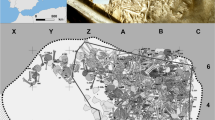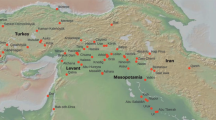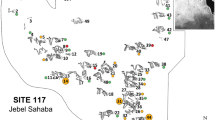Abstract
Neanderthals are commonly depicted as leading dangerous lives and permanently struggling for survival. This view largely relies on the high incidences of trauma that have been reported1,2 and have variously been attributed to violent social behaviour3,4, highly mobile hunter-gatherer lifestyles2 or attacks by carnivores5. The described Neanderthal pattern of predominantly cranial injuries is further thought to reflect violent encounters with large prey mammals, resulting from the use of close-range hunting weapons1. These interpretations directly shape our understanding of Neanderthal lifestyles, health and hunting abilities, yet mainly rest on descriptive, case-based evidence. Quantitative, population-level studies of traumatic injuries are rare. Here we reassess the hypothesis of higher cranial trauma prevalence among Neanderthals using a population-level approach—accounting for preservation bias and other contextual data—and an exhaustive fossil database. We show that Neanderthals and early Upper Palaeolithic anatomically modern humans exhibit similar overall incidences of cranial trauma, which are higher for males in both taxa, consistent with patterns shown by later populations of modern humans. Beyond these similarities, we observed species-specific, age-related variation in trauma prevalence, suggesting that there were differences in the timing of injuries during life or that there was a differential mortality risk of trauma survivors in the two groups. Finally, our results highlight the importance of preservation bias in studies of trauma prevalence.
This is a preview of subscription content, access via your institution
Access options
Access Nature and 54 other Nature Portfolio journals
Get Nature+, our best-value online-access subscription
$29.99 / 30 days
cancel any time
Subscribe to this journal
Receive 51 print issues and online access
$199.00 per year
only $3.90 per issue
Buy this article
- Purchase on Springer Link
- Instant access to full article PDF
Prices may be subject to local taxes which are calculated during checkout



Similar content being viewed by others
Data availability
Specimen-level data that support the findings of this study are provided in Supplementary Tables 1, 2. Quantification data for skeletal elements are available from the corresponding author upon reasonable request. Source Data for Figs. 2, 3 and Extended Data Figs. 1, 2 are provided in the online version of the paper.
References
Berger, T. D. & Trinkaus, E. Patterns of trauma among the Neandertals. J. Archaeol. Sci. 22, 841–852 (1995).
Underdown, S. A comparative approach to understanding Neanderthal trauma. Period. Biol. 108, 485–493 (2006).
Courville, C. B. in Diseases in Antiquity (eds Brothwell, D. R. & Sandison, A. T.) 606–622 (C. C. Thomas, Springfield, 1967).
Hutton Estabrook, V. & Frayer, D. W. in The Routledge Handbook of the Bioarchaeology of Human Conflict (eds Knüsel, C. J. & Smith, M. J.) 67–89 (Routledge, London, 2014).
Camarós, E., Cueto, M., Lorenzo, C., Villaverde, V. & Rivals, F. Large carnivore attacks on hominins during the Pleistocene: a forensic approach with a Neanderthal example. Archaeol. Anthropol. Sci. 8, 635–646 (2016).
Trinkaus, E. Hard times among the Neanderthals. Nat. Hist. 87, 58–63 (1978).
Trinkaus, E. Neanderthal mortality patterns. J. Archaeol. Sci. 22, 121–142 (1995).
Pettitt, P. B. Neanderthal lifecycles: developmental and social phases in the lives of the last archaics. World Archaeol. 31, 351–366 (2000).
Klein, R. G. The Human Career. Human Biological and Cultural Origins 3rd edn (Univ. Chicago Press, Chicago, 2009).
Kunter, M. Gewalt- und Arbeitsverletzungen in alter Zeit. Knochenfunde als Geschichtsquelle. Spiegel der Forschung 3, 70–72 (1986).
Nakahashi, W. The effect of trauma on Neanderthal culture: a mathematical analysis. Homo 68, 83–100 (2017).
Mcbrearty, S. & Brooks, A. S. The revolution that wasn’t: a new interpretation of the origin of modern human behavior. J. Hum. Evol. 39, 453–563 (2000).
Trinkaus, E., Buzhilova, A. P., Mednikova, M. B. & Dobrovolskaya, M. V. (eds) in The People of Sunghir 269–294 (Oxford Univ. Press, Oxford, 2014).
Brennan, M. U. Health and Disease in the Middle and Upper Paleolithic of southwestern France: a Bioarcheological Study. PhD thesis, New York Univ. (1991).
Hutton Estabrook, V. Sampling Biases and New Ways of Addressing the Significance of Trauma in Neandertals. PhD thesis, Michigan Univ. (2009).
Hutton Estabrook, V. Is trauma at Krapina like all other Neandertal trauma? A statistical comparison of trauma patterns in Neandertal skeletal remains. Period. Biol. 109, 393–400 (2007).
Trinkaus, E. Neandertals, early modern humans, and rodeo riders. J. Archaeol. Sci. 39, 3691–3693 (2012).
Larsen, C. S. Bioarcheology. Interpreting Behavior from the Human Skeleton (Cambridge Univ. Press, Cambridge, 1997).
Jurmain, R. Stories from the Skeleton. Behavioural Reconstruction in Human Osteology (Gordon & Breach, Amsterdam, 1999).
Martin, D. L. & Harrod, R. P. Bioarchaeological contributions to the study of violence. Am. J. Phys. Anthropol. 156, 116–145 (2015).
Redfern, R. C. Injury and Trauma in Bioarchaeology. Interpreting Violence in Past Lives (Cambridge Univ. Press, Cambridge, 2016).
Campillo, D. Healing of the skull bone after injury. J. Paleopathol. 3, 137–149 (1991).
Terberger, T. in Frühe Spuren der Gewalt (eds Pieck, J. & Terberger, T.) 129–154 (Landesamt für Kultur und Denkmalpflege, Schwerin, 2006).
Fibiger, L., Ahlström, T., Bennike, P. & Schulting, R. J. Patterns of violence-related skull trauma in Neolithic Southern Scandinavia. Am. J. Phys. Anthropol. 150, 190–202 (2013).
Jiménez-Brobeil, S. A., du Souich, P. & Al Oumaoui, I. Possible relationship of cranial traumatic injuries with violence in the south-east Iberian Peninsula from the Neolithic to the Bronze Age. Am. J. Phys. Anthropol. 140, 465–475 (2009).
Schwitalla, A. W., Jones, T. L., Pilloud, M. A., Codding, B. F. & Wiberg, R. S. Violence among foragers: the bioarchaeological record from central California. J. Anthropol. Archaeol. 33, 66–83 (2014).
Cohen, H. et al. Trauma to the skull. A historical perspective from the Southern Levant (4300bce–1917ce). Int. J. Osteoarchaeol. 24, 722–736 (2014).
Glencross, B. & Sawchuk, L. The person-years construct: ageing and the prevalence of health related phenomena from skeletal samples. Int. J. Osteoarchaeol. 13, 369–374 (2003).
Boldsen, J. L., Milner, G. R. & Weise, S. Cranial vault trauma and selective mortality in medieval to early modern Denmark. Proc. Natl Acad. Sci. USA 112, 1721–1726 (2015).
Milner, G. R. & Boldsen, J. L. Life not death: epidemiology from skeletons. Int. J. Paleopathol. 17, 26–39 (2017).
Eriksson, M., Brattström, O., Larsson, E. & Oldner, A. Causes of excessive late death after trauma compared with a matched control cohort. Br. J. Surg. 103, 1282–1289 (2016).
Mitchell, R. J., Cameron, C. M. & McClure, R. Higher mortality risk among injured individuals in a population-based matched cohort study. BMC Public Health 17, 150 (2017).
Buikstra, J. E. & Ubelaker, D. H. (eds) Standards for Data Collection from Human Skeletal Remains. Arkansas Archeological Survey Research Series No. 44 (Arkansas Archeological Survey, Fayetteville, 1994).
Judd, M. A. Comparison of long bone trauma recording methods. J. Archaeol. Sci. 29, 1255–1265 (2002).
Hadfield, J. D. MCMC Methods for Multi-Response Generalized Linear Mixed Models. The MCMCglmmR Package. J. Stat. Softw. 33, 1–22 (2010).
R Core Team. R: A Language and Environment for Statistical Computing http://www.R-project.org/ (R Foundation for Statistical Computing, Vienna, 2017).
Walker, P. L. Cranial injuries as evidence of violence in prehistoric southern California. Am. J. Phys. Anthropol. 80, 313–323 (1989).
Hadfield, J. MCMCglmm Course Notes https://cran.r-project.org/web/packages/MCMCglmm/vignettes/CourseNotes.pdf (2017).
Gelman, A. & Hill, J. Data Analysis Using Regression and Multilevel/Hierarchical Models (Cambridge Univ. Press, Cambridge, 2006).
Gelman, A. & Rubin, D. B. Inference from iterative simulation using multiple sequences. Stat. Sci. 7, 457–472 (1992).
Acknowledgements
We thank J. Svoboda, S. Sázelová (Paleolithic and Paleoanthropology Research Center, Dolní Vĕstonice), M. Oliva and Z. Tvrdý (Moravian Museum, Anthropos Institute, Brno) for permission to study the Dolní Vĕstonice, Pavlov and Brno collections, and L. Limmer for her contribution. This research is funded by the German Research Foundation (DFG-HA-5258/12-1, DFG-WA-2808/2-1) and supported by the University of Tübingen and Senckenberg Gesellschaft für Naturforschung. K.H. is supported by ERC-CoG-724703 and DFG-FOR-2237.
Reviewer information
Nature thanks S. Black, M. Mirazón Lahr and the other anonymous reviewer(s) for their contribution to the peer review of this work.
Author information
Authors and Affiliations
Contributions
J.B., J.W. and K.H. conceived the study. J.B. collected data. J.B., J.W., K.H. and N.A. developed the methods. J.B. and N.A. analysed the data. J.B., J.W., K.H. and N.A. wrote the manuscript.
Corresponding author
Ethics declarations
Competing interests
The authors declare no competing interests.
Additional information
Publisher’s note: Springer Nature remains neutral with regard to jurisdictional claims in published maps and institutional affiliations.
Extended data figures and tables
Extended Data Fig. 1 Ratio of skeletal elements with and without trauma.
a, Ratios of skeletal elements with and without trauma per preservation category for the full dataset of n = 836 skeletal elements. b, Ratios of skeletal elements with and without trauma per age cohort (young or old) and taxon (Neanderthals or Upper Palaeolithic modern humans), excluding sex unknown and age indeterminate skeletal elements (n = 604). Sample sizes given below bars represent numbers of skeletal elements of each subsample.
Extended Data Fig. 2 Preservation of skeletal elements of Neanderthals and Upper Palaeolithic modern humans.
a, Number of skeletal elements in each preservation category for Neanderthals and Upper Palaeolithic modern humans for the full dataset of n = 836 skeletal elements. b–e, Percentages of the four preservation categories for each skeletal element for Neanderthals (b; full dataset, n = 295 skeletal elements), Upper Palaeolithic modern humans (c; full dataset, n = 541 skeletal elements), Neanderthals (d; reduced dataset, excluding age indeterminate and sex unknown elements, n = 198) and Upper Palaeolithic modern humans (e; reduced dataset, excluding age indeterminate and sex unknown elements, n = 406). L and R indicate left and right, respectively.
Supplementary information
Supplementary Tables
This file contains Supplementary Tables 1-3. Supplementary Table 1: Individual data of Neanderthal specimens used in this study. Supplementary Table 2: Individual data of Early Upper Paleolithic modern human specimens used in this study. Supplementary Table 3: Catalogue of single cranial traumatic lesions of Neanderthals and early Upper Paleolithic modern humans used in this study with referenced short descriptions. Supplementary References: Bibliography of references cited in Supplementary Tables 1-3.
Rights and permissions
About this article
Cite this article
Beier, J., Anthes, N., Wahl, J. et al. Similar cranial trauma prevalence among Neanderthals and Upper Palaeolithic modern humans. Nature 563, 686–690 (2018). https://doi.org/10.1038/s41586-018-0696-8
Received:
Accepted:
Published:
Issue Date:
DOI: https://doi.org/10.1038/s41586-018-0696-8
Keywords
Comments
By submitting a comment you agree to abide by our Terms and Community Guidelines. If you find something abusive or that does not comply with our terms or guidelines please flag it as inappropriate.



